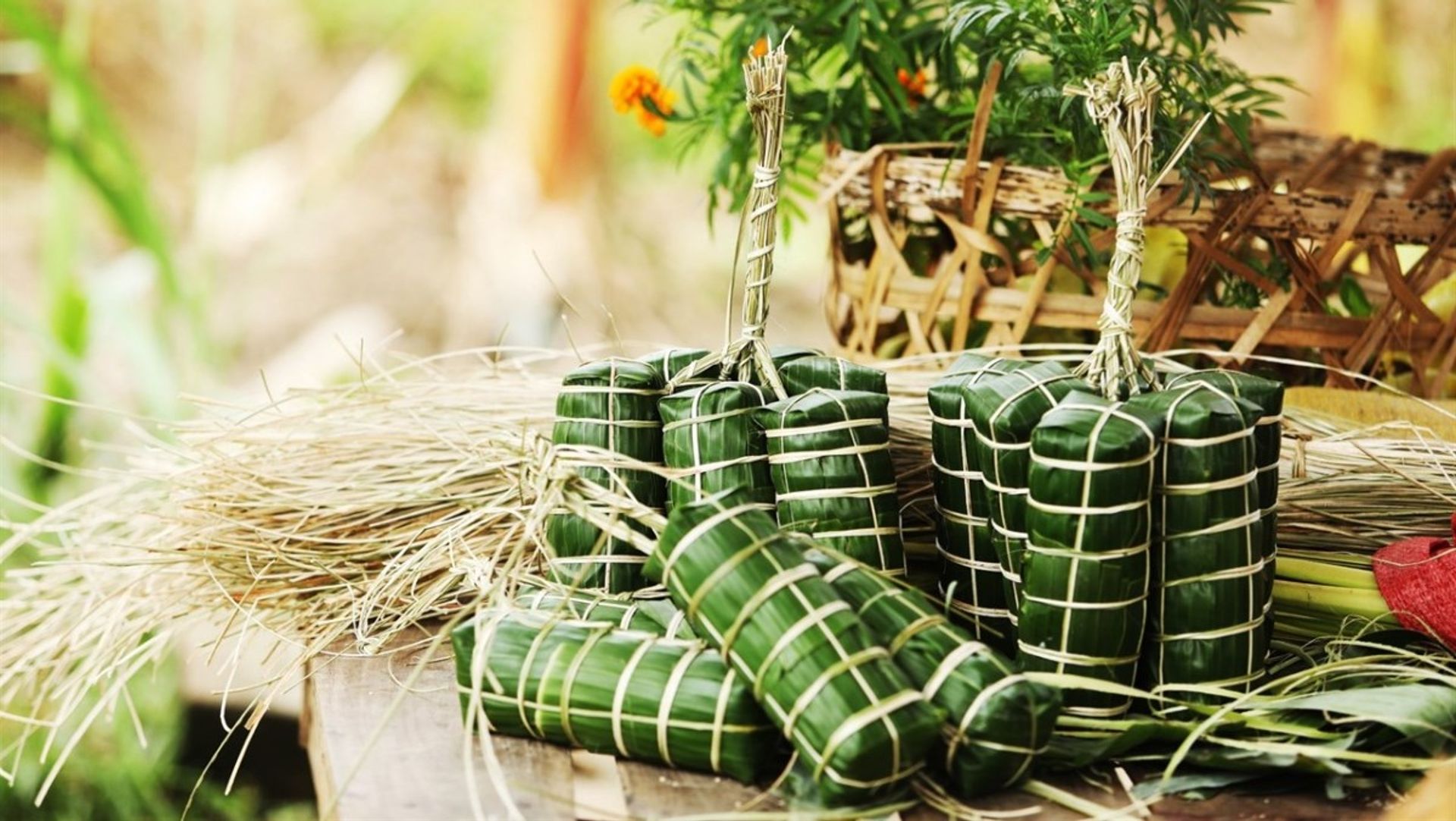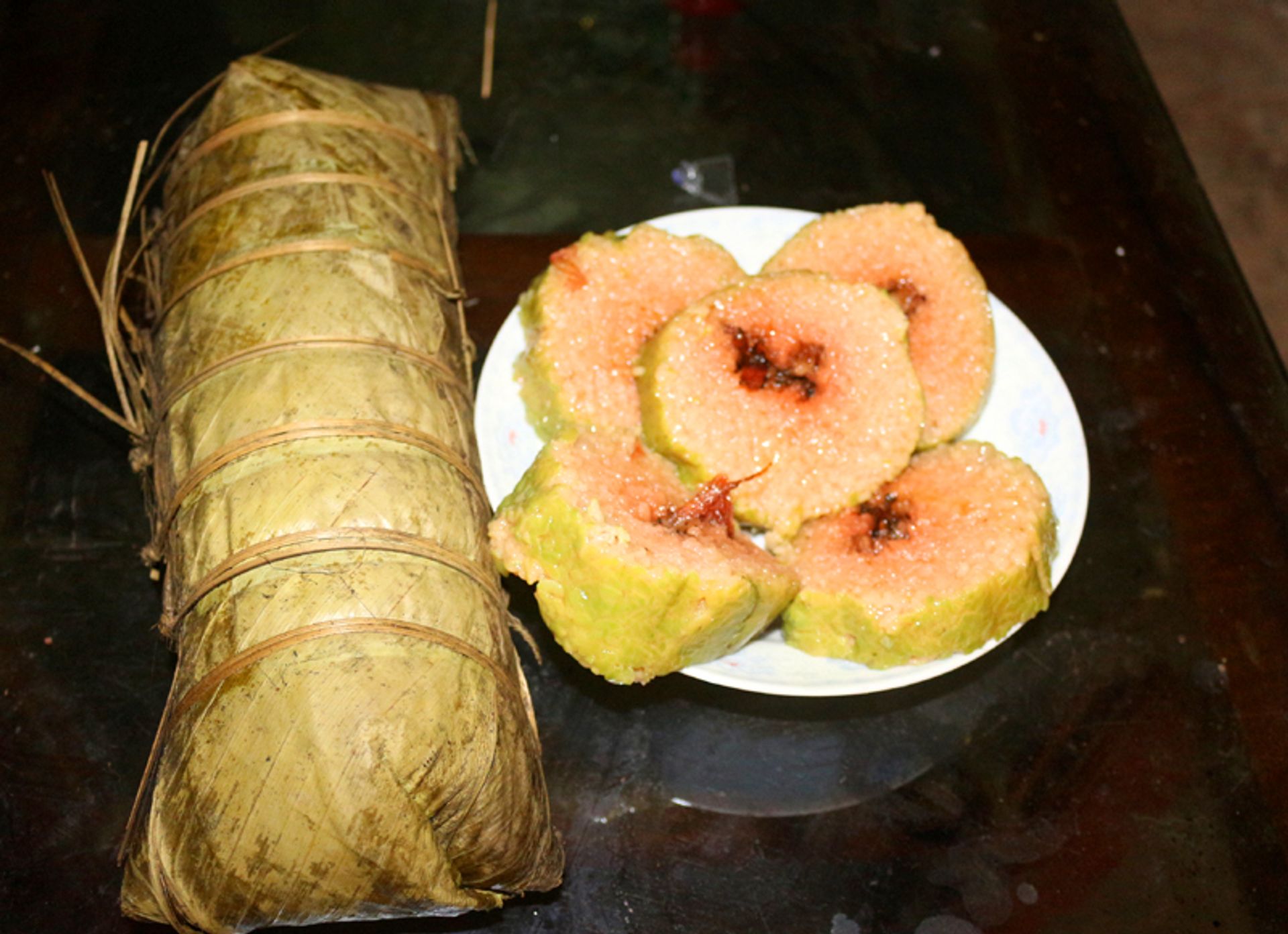Chung cake with feathered rice is a very popular cake on Tet holidays and weddings in Hai Ha, Quang Ninh. What makes banh chung with rice feathers different from other types of banh chung is its filling. Besides the ingredients like other banh chung (rice, meat, beans, pepper), the difference is the addition of finely ground feathered rice leaves. This is a type of leaf that grows a lot locally, has a fragrant, cool, sweet taste, and especially has the effect of clearing heat and promoting health. When cooked or pureed, the leaves of the anchovy plant also have a burgundy color, which is extremely beautiful and eye-catching.
Wrapping rice cake with feathered rice is the same as other types of banh chung, only, after spreading sticky rice once, the natives also sprinkle another layer of finely ground feathered rice leaves on top of the rice, followed by a layer of meat. then add a layer of feathery rice leaves and a layer of sticky rice on top, then tighten. Banh chung with feathered rice is boiled for about 9-12 hours until the sticky rice and the filling are mixed and finely chopped. The pot of banh chung was boiling with the scent of fragrant rice cake from the kitchen, wafting out into the heart of a small neighborhood. Banh chung with feathered rice has a very distinct aroma, when cut to eat, the filling is burgundy, the longer it is left, the more it will turn crimson, which looks very eye-catching.
When eating, people take the wire to wrap the cake to cut it into slices, arrange it on a plate very beautifully. Just once enjoying the banh chung with feather rice of the Hai Ha people, many tourists cannot forget the fleshy, fragrant and greasy taste of the cake. On Tet holidays, many people often order fluffy rice cakes at families specializing in wrapping traditional cakes in Hai Ha to give as gifts to relatives and family or to serve as dishes in the tray. Banh chung with hairy rice shows the richness and diversity of culture through the lens of cuisine, as well as the creativity and adaptation of Hai Ha people.
- Address to buy: Hai Ha, Quang Ninh
Source: Collected internet.
The streets paint the lives of Vietnamese people. The streets here are not just for traveling. Streets and sidewalks are also places to shop, eat, meet for a cup of coffee, get a haircut or rest. Big cities are always full of life with the roar of millions of motorbikes, where you can feel a constant source of energy bubbling on every street.
Vietnam is located in the Indomalaya ecological region. According to the 2005 National Environmental Status Report, Vietnam is among the 25 countries with high levels of biodiversity, ranked 16th worldwide in terms of biodiversity and is home to about 16% of the world's biodiversity. species in the world. 15,986 plant species have been found throughout the country, of which 10% are endemic. Vietnam has 307 species of nematodes, 200 species of oligochaeta, 145 species of acarina, 113 species of springtails, 7,750 species of insects, 260 species of reptiles. , 120 species of amphibians, 840 species of birds and 310 species of mammals, of which 100 species of birds and 78 species of mammals are endemic. There are also 1,438 species of freshwater algae, accounting for 9.6% of the total number of algae species, as well as 794 species of aquatic invertebrates and 2,458 species of marine fish. In the late 1980s, a population of Javan Rhinos was discovered in Cat Tien National Park and it is possible that the last individual of this species in Vietnam died in 2010.
The cultural identity of ethnic groups is clearly expressed in community life and in economic activities from customs, costumes to culinary styles. Below are the unique features of Vietnamese culture that you can learn about.
Vietnam is a country with 54 different ethnic groups, each of which has its own unique and impressive culture and identity. It is this difference in ethnic composition that has contributed to creating a very diverse, rich and unique beauty for Vietnam's culture that no other country can replace. Customs in Vietnam have a long tradition spanning thousands of years, it has become customary law, deep and firmly embedded in the hearts of every Vietnamese person.

